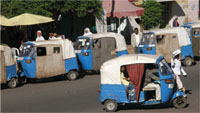7.4.1 Causes, signs and symptoms of head and spinal injuries
Head injuries usually occur from blows to the brain. Injuries to the head may include fracture of the bones of the face or the skull, swelling of the brain due to inflammation and fluid collecting inside the skull after a blow to the head, or cuts to the scalp and other soft tissues around the skull. Spinal injury is when the backbone and the nerve tissue inside the spine are injured.
Certain causes of injury should alert you to possible head and spinal damage. These include a fall from any height (e.g. from a horse, motorbike, bicycle, or building), a penetrating injury to the head from a gun or knife, a heavy blow to the head, or a traffic accident (Figure 7.6). When you are called to see a person after any of these events, you should suspect the possibility of head or spinal injuries. These accidents are also common to fracture injuries. The symptoms and signs of head injury or spinal injury are given in Box 7.3.

Box 7.3 Signs of head or spinal injury
You may find these signs either separately or in combination:
- Unconsciousness or reduced level of consciousness
- Confusion in the patient’s speech or behaviour
- Visible cuts or bruises to the scalp
- Blood or fluid coming out through the nose or ears
- Unexplained headache or disturbance to sight
- Difficulty breathing
- Extreme pain or pressure in the neck, head or back
- Tingling or loss of sensation in the hands, fingers, feet or toes
- Partial or complete loss of control over any part of the body, including urination and defaecation (passing stool)
- Difficulty with balance and walking.
7.4 Head and spinal injury
